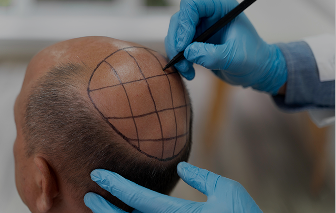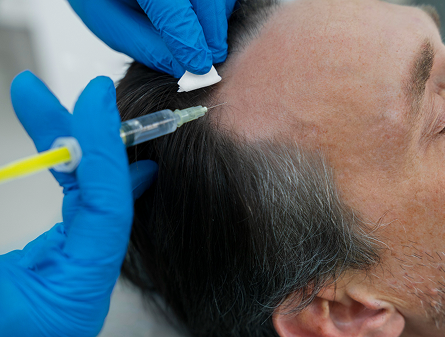A hair transplant is a surgical procedure where healthy hair is extracted from the back of the scalp or donor area and implanted into the balding area. This can provide a long-term solution to hair loss but is best suited to those whose hair loss has stabilised. Dutasteride is a a treatment for pattern hair loss which was originally used to treat enlarged prostates.
It is a highly effective dihydrotestosterone (DHT) blocker that is usually prescribed off-label if another DHT blocker like finasteride has not provided hair regrowth. A hair transplant can have a high survival rate of new hairs but proper aftercare must be observed for the best results.
Dutasteride is a potent DHT blocker that targets all three types of isoenzymes responsible for the conversion of testosterone into DHT. Explore the comparison table below to see the differences between a hair transplant and dutasteride.
- Hair transplants relocate follicles to bald areas for permanent results.
- Unlike Dutasteride, it offers a physical restoration without medication.
- Dutasteride is an oral medication that blocks DHT more effectively than Finasteride.
- Compared to hair transplants, it is non-surgical and preventative rather than restorative.
- Hair transplants cost between $5,000–$15,000 in Australia.
- High single expense but no recurring cost post-procedure.
- Dutasteride typically costs $40–$80 monthly, requiring ongoing prescriptions.
- Unlike hair transplants, costs accumulate over time with continued use.
- Hair transplants take 1–2 sessions, with results visible in 6–12 months.
- No daily maintenance needed after recovery.
- Dutasteride is taken daily and starts showing results within 3–6 months.
- Compared to transplants, it requires an indefinite routine.
- Hair transplants involve the surgical relocation of hair follicles using FUE or FUT techniques.
- Provides immediate visible changes.
- Dutasteride reduces DHT by blocking the enzyme activity systemically.
- Unlike transplants, it doesn’t create new hair but preserves remaining follicles.
- Hair transplants carry surgical risks such as infection and scarring.
- Considered safe with a qualified practitioner.
- Dutasteride may cause side effects like reduced libido or hormonal changes.
- Compared to hair transplants, it affects internal systems and requires medical monitoring.
- Transplants are a one-time clinical procedure followed by recovery.
- No daily upkeep once healing is complete.
- Dutasteride is taken as a pill once per day.
- Unlike transplants, it’s easier day-to-day but requires consistency.
- Hair transplants require specialised clinics and surgeons.
- Less accessible due to cost, location, and availability.
- Dutasteride is prescription-only but can be obtained through GPs in Australia.
- Compared to hair transplants, it’s more widely accessible and affordable.
- Transplanted follicles grow permanently if post-op care is followed.
- After recovery, no ongoing intervention is needed, but surrounding hairs may still fall out.
- Dutasteride preserves hair while taken, but any hair growth can reverse if stopped.
- Unlike transplants, its results are not permanent without ongoing use.
- Hair transplants are often paired with medications like dutasteride or minoxidil to manage hair loss surrounding the transplant site.
- Some use a hair transplant as a single solution before trying other treatments or if medications aren’t doing enough.
- Dutasteride is commonly used alongside transplants to preserve existing hair.
- Compared to surgery, it’s more preventive than corrective and may be paired with stimulating medications like minoxidil.
- Hair transplants offer an immediate, visible transformation.
- Seen as a bold, definitive action for hair restoration.
- Dutasteride appeals to users seeking gradual improvement without surgery.
- Unlike transplants, it offers internal change over time.
- Hair transplants restore hairlines and density but don’t affect overall health.
- Limited to cosmetic outcomes.
- Dutasteride reduces DHT and may benefit prostate health in men.
- Compared to transplants, it provides systemic hormonal changes.
- Hair transplants generate one-time medical waste.
- Minimal ongoing environmental footprint.
- Dutasteride creates regular pharmaceutical packaging waste.
- Less eco-friendly than a single surgical procedure.
Shop our hair solutions
We are committed to providing affordable hair regeneration services for people all over Australia. Our formula can help you regain your confidence.
Shop Now

Hair Transplant vs Dutasteride Regrowth Solutions Comparison Summary
A hair transplant can provide effective results, particularly for those in the early stages of hair loss or thinning. If your hair loss continues to advance, the hair around the treatment area will continue to fall out creating an undesirable appearance.
This means that the treatment may need to be supplemented with pharmaceutical medications to prevent further hair loss depending on the progression of your hair fall. Dutasteride is designed to be used as a long-term treatment to inhibit the progression of hair loss and encourage healthy hair regrowth.
The results can be longer-lasting compared to other DHT blockers like finasteride as it has a longer half-life and its effect in binding to isoenzymes is irreversible. A hair transplant can be a considerable investment with not only money but time needed before and after the surgery to prepare and recover.
Dutasteride is typically more expensive compared to finasteride but is a less expensive commitment up-front.
User Guidance
A hair transplant requires a considerable time commitment with the surgery taking place over a day and the aftercare requiring several weeks. Dutasteride can fit into your daily routine more easily as an oral medication but comes with some potential side effects.
These mostly relate to sexual function including decreased libido, ejaculation issues, and impotence. Since a hair transplant is a surgical procedure it can come with some potential risks such as bleeding and infection. The potential for adverse effects can depend on the skill of the surgeon you choose and the quality of the clinic and equipment.
Take Our Hair Loss Quiz to See Which Treatment Suits You?
Take A Hair Quiz

Frequently Asked Questions
We have put some commonly asked questions.
Nunc scelerisque tincidunt elit. Vestibulum non mi ipsum. Cras pretium suscipit tellus sit amet aliquet. Vestibulum maximus lacinia massa nontor.
Platelet-rich plasma (PRP) treatment involves drawing blood from the patient, isolating the beneficial nutrients and injecting it into the scalp where hair loss is occurring. This promotes hair growth and has many other applications from encouraging healing to skin rejuvenation.
Platelet-rich plasma (PRP) treatment involves drawing blood from the patient, isolating the beneficial nutrients and injecting it into the scalp where hair loss is occurring. This promotes hair growth and has many other applications from encouraging healing to skin rejuvenation.
Platelet-rich plasma (PRP) treatment involves drawing blood from the patient, isolating the beneficial nutrients and injecting it into the scalp where hair loss is occurring. This promotes hair growth and has many other applications from encouraging healing to skin rejuvenation.







 See All
See All